Mon-Fri 9am - 5pm Mountain time
Balsam Poplar vs Thornless Honeylocust
Populus balsamifera
Gleditsia triacanthos inermis
Balsam Poplar is a hardy, fast-growing deciduous tree that is Native to Canada east of the Rockies.
We grow them in two variations. Sometimes they are a male clones, so they don't produce fluff. Other times, we grow them from seed, which will result in fluff. The detailed descriptions (see below) will tell you which is which.
Thornless Honey Locust makes an excellent shade tree with its lacy foliage and dappled shade. The leaves are honey-yellow, light and airy, providing interesting color and texture to your landscape. This variety is thornless, and the seeds and pods provide food for wildlife such as deer and squirrels.
The Thornless Honey Locust is tolerant of drought, various soil conditions, and even road salt.
Balsam Poplar Quick Facts
Thornless Honeylocust Quick Facts
In row spacing: 2.4 - 3 m (8 - 10 ft)

